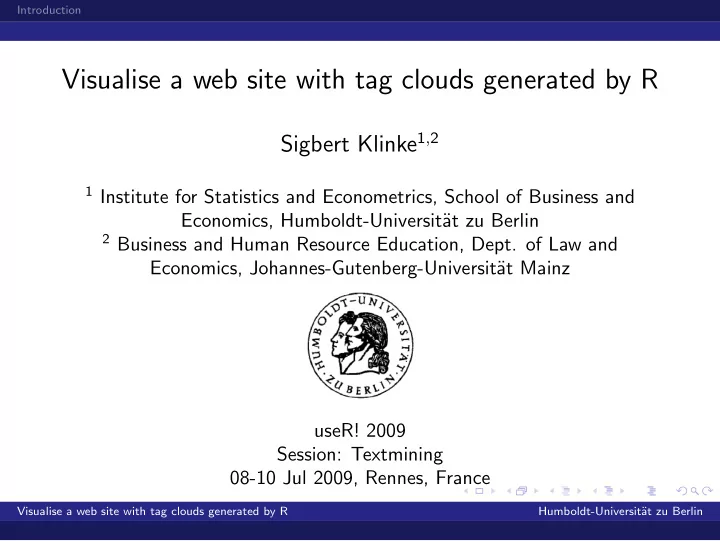

Introduction Visualise a web site with tag clouds generated by R Sigbert Klinke 1 , 2 1 Institute for Statistics and Econometrics, School of Business and Economics, Humboldt-Universit¨ at zu Berlin 2 Business and Human Resource Education, Dept. of Law and Economics, Johannes-Gutenberg-Universit¨ at Mainz useR! 2009 Session: Textmining 08-10 Jul 2009, Rennes, France Visualise a web site with tag clouds generated by R Humboldt-Universit¨ at zu Berlin
Introduction Problem: Redirection of web users Changes to web site structure produces errors on access How can we redirect the users to a large number of pages? Solution: Use a tag cloud where the size of an entry corresponds to the number of visits in the past year Visualise a web site with tag clouds generated by R Humboldt-Universit¨ at zu Berlin
Introduction Problem: Teaching statistics Wikipedia is often a (starting) source for students Dictionary structure does not allow for an overview of a topic Solution: Use a tag cloud to visualise the neighbourhood Links to Moment , Wahrschein- of a page lichkeitsverteilung , ... Visualise a web site with tag clouds generated by R Humboldt-Universit¨ at zu Berlin
Introduction Wikipedia structure Visualise a web site with tag clouds generated by R Humboldt-Universit¨ at zu Berlin
Introduction Work flow PHP script crawls Wikipedia and stores the link structure crawler from http://w-shadow.com using cURL store in csv format: fromPage ; toPage R generates a tag cloud for each page load linkstructure read.csv build link network: igraph by Gabor Csardi for importance compute pagerank page.rank (font size) extract neighbourhood graph.neighborhood (of distance 1) compute (bivariate) positions layout.mds (location) Visualise a web site with tag clouds generated by R Humboldt-Universit¨ at zu Berlin
Introduction igraph ( layout.mds ) create HTML tag clouds create dendrogram from positions (table-based) use a top/bottom - left/right approach (compact) use one dimensional MDS (oneliner) Visualise a web site with tag clouds generated by R Humboldt-Universit¨ at zu Berlin
Introduction Tag cloud: table-based Most page titles are long (e.g. Moment (mathematics) ) Take hyphenation into account Visualise a web site with tag clouds generated by R Humboldt-Universit¨ at zu Berlin
Introduction T EX hyphenation utilise the T EX hyphenation Perl program available TeX::hyphen by Jan Pazdziora hyphen.pl with german hyphenation by Tilman Kranz add ​ (zero width space) Visualise a web site with tag clouds generated by R Humboldt-Universit¨ at zu Berlin
Introduction Tag cloud: compact algorithm needs some more polishing Visualise a web site with tag clouds generated by R Humboldt-Universit¨ at zu Berlin
Introduction Tag cloud: one liner Visualise a web site with tag clouds generated by R Humboldt-Universit¨ at zu Berlin
Introduction createTagCloud parameters g igraph object graph.order size of neighbourhood (currently only 1 ) graph.layout layout function from igraph ( layout.mds ) fontsize.method method to compute the font size ( page.rank.vector ) fontsize.transform transformation method for font size ( log10 ) fontsize.min font size minimum ( 7.5 ) fontsize.max font size maximum ( 20.5 ) buildHTML.method method to build tag cloud(s) ( one ) buildHTML.landscape landscape format ( T ) buildHTML.hyphenate should T EX hyphenation be applied ( TRUE ) file.html name(s) of HTML/PNG file(s) file.png ( vertex%i.html , vertex%i.png ) no index of vertices for which tag clouds are generated ( NA ) ... further parameters Visualise a web site with tag clouds generated by R Humboldt-Universit¨ at zu Berlin
Introduction Outlook Use Wikipedia XML dump instead own web crawler Account for redirects in Wikipedia Add “virtual” links Analyse text (TreeTagger) Colour links in tag cloud (Inbound, Outbound, Bidirectional) Increase neighbourhood Add MediaWiki output Improve hyphenations? Visualise a web site with tag clouds generated by R Humboldt-Universit¨ at zu Berlin
Introduction Literature/Links Csardi, G. (2009): igraph , http://cran.r-project.org/web/packages/igraph Kaser, O., Lemire, D. (2007): Tag-cloud Drawing: Algorithms for Cloud visualization, arXiv, http://arxiv.org/abs/cs/0703109 Kranz, T. (2009): hyphen.pl , http://tk-sls.de/texte/sil-ben-tren-nung.html Liang, F.M. (1983): Word Hy-phen-a-tion by Com-put-er, Stanford University, CA 94305, Report No. STAN-CS-83-977. M¨ unz, S. et al. (2007): SELFHTML 8.1.2 , http://de.selfhtml.org/ Pazdziora, J. (2002): TeX::Hyphen , http://search.cpan.org/dist/TeX-Hyphen Visualise a web site with tag clouds generated by R Humboldt-Universit¨ at zu Berlin
Recommend
More recommend